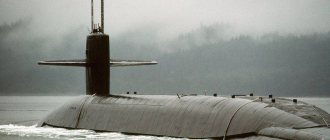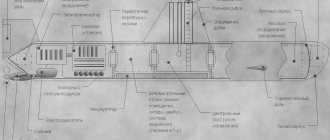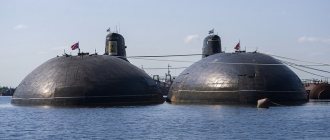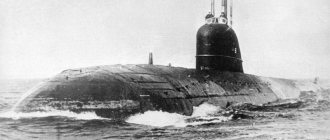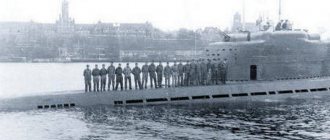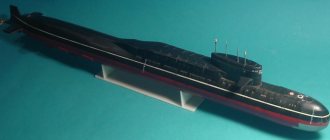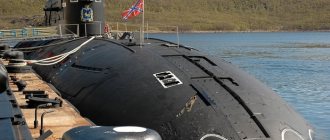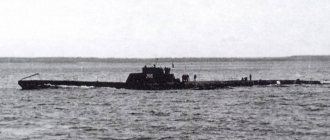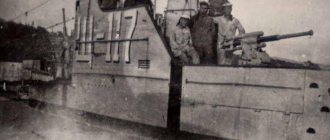Underwater enemy. Los Angeles-class nuclear submarine
The history of Los Angeles-type atomic killers began in 1906, when a family of emigrants from the Russian Empire - Abraham, Rachel and their six-year-old son Chaim - entered the hall of the Immigration Service of Ellis Island (New Jersey). The kid turned out to be no slouch - when he grew up, he entered the Naval Academy and became a four-star admiral in the US Navy. In total, Hyman Rickover served in the Navy for 63 years and would have served more if he had not been caught taking a bribe of 67 thousand dollars (Rickover himself denied it to the end, declaring that this “nonsense” had no influence on his decisions).
In 1979, after a major accident at the Three Mile Island nuclear power plant, Hyman Rickover, as an expert, was called to testify before Congress. The question sounded prosaic: “One hundred nuclear submarines of the US Navy are moving in the depths of the oceans - and not a single accident with the reactor core in 20 years. And then the new nuclear power plant standing on the shore collapsed. Maybe Admiral Rickover knows some magic word?
The elderly admiral's answer was simple: there are no secrets, you just need to work with people. Personally communicate with each specialist, immediately remove fools from working with the reactor and kick them out of the fleet. All high ranks who, for some reason, interfere with the training of personnel in accordance with these principles and sabotage the implementation of my instructions, declare a merciless war and also expel them from the fleet. Ruthlessly “gnaw” contractors and engineers. Safety and reliability are the main areas of work, otherwise even the most powerful and modern submarines will be sunk in batches in peacetime.
Admiral Rickover's principles (safety and reliability above all) formed the basis of the Los Angeles project, the largest series in the history of the nuclear submarine fleet, consisting of 62 multipurpose nuclear submarines. The purpose of the “Los Angeles” (or “Losey” - the nickname of the boats in the Soviet fleet) is to fight enemy surface ships and submarines, cover aircraft carrier groups and deployment areas of strategic submarine missile carriers. Covert mining, reconnaissance, special operations.
If we take as a basis only the tabular characteristics: “speed”, “immersion depth”, “number of torpedo tubes”, then against the background of domestic “Typhoons”, “Anteev” and “Pike”, “Los Angeles” looks like a mediocre trough. A single-hull steel coffin divided into three compartments - any hole would be fatal to it. For comparison, the durable hull of the domestic multi-purpose nuclear submarine Project 971 “Shchuka-B” is divided into six sealed compartments. And the giant Project 941 Akula missile carrier has 19 of them!
There are only four torpedo tubes located at an angle to the center plane of the hull. As a result, the “Moose” cannot fire at full speed - otherwise the torpedo will simply be broken by the incoming stream of water. For comparison, the Shchuka-B has 8 bow-mounted tubes and is capable of using its weapons over the entire range of operating depths and speeds. The working depth of the Los Angeles is only 250 meters. A quarter of a kilometer – is that really not enough? For comparison, the working depth of the Shchuka-B is 500 meters, the maximum is 600!
Canonical image of the Los Angeles-class nuclear submarine
Boat speed. Surprisingly, things are not so bad for the American here – in a submerged position, the “Moose” is capable of accelerating to 35 knots. The result is more than worthy, only six knots less than the incredible Soviet Lyra (Project 705). And this is without the use of titanium cases and scary reactors with metal coolants!
On the other hand, high maximum speed has never been the most important parameter of a submarine - already at 25 knots of acoustics the boats stop hearing anything due to the noise of the incoming water and the submarine becomes “deaf”, and at 30 knots the boat rumbles so much that it heard at the other end of the ocean. High speed is a useful, but not very important quality.
The main weapon of any submarine is stealth. This parameter contains the whole meaning of the existence of the submarine fleet. Stealth is determined primarily by the submarine's own noise level. The noise level of the Los Angeles-class nuclear submarines did not just meet international standards. The Los Angeles-class submarine itself set world standards. There were several reasons for the exceptional low noise of the Elks:
- single-hull design. The area of the wetted surface decreased, and, as a result, the noise from friction with the water when the boat moved.
- quality of manufacturing of screws. By the way, the manufacturing quality of the third-generation Soviet nuclear submarine propellers also increased (and their noise decreased) after the detective story with the purchase of high-precision metal-cutting machines from Toshiba. Having learned about the secret deal between the USSR and Japan, America threw such a scandal that poor Toshiba almost lost access to the American market. Late! “Pike-B” with new propellers have already entered the vastness of the World Ocean.
— some specific points, such as rational placement of equipment inside the boat, depreciation of turbines and power equipment. The reactor circuits have a high degree of natural coolant circulation - this made it possible to abandon high-capacity pumps and, consequently, reduce the noise of the Los Angeles.
It is not enough for a submarine to be fast and secretive - to successfully complete its missions, it is necessary to have a specific understanding of the surrounding environment, learn to navigate the water column, find and identify surface and underwater targets. For a long time, the only means of external detection were a periscope and a hydroacoustic post with an analyzer in the form of an acoustic sailor’s ear. Well, there’s also a gyrocompass that shows where the North is under this damn water.
In Los Angeles everything is much more interesting. American engineers played all-in - they removed all equipment from the bow of the boat, including torpedo tubes. As a result, the entire bow of the hull is occupied by a spherical antenna of the AN/BQS-13 hydroacoustic station with a diameter of 4.6 meters. Also, the submarine’s hydroacoustic complex includes a conformal side-scan antenna consisting of 102 hydrophones, an active high-frequency sonar for detecting natural obstacles (underwater rocks, ice fields on the water surface, mines, etc.), as well as two towed passive antennas of 790 and 930 meters (including cable length).
Other means of collecting information include: equipment for measuring the speed of sound at various depths (an absolutely necessary tool for accurately determining the distance to a target), AN/BPS-15 radar and AN/WLR-9 electronic reconnaissance system (for work on the surface), periscope general overview (type and attack periscope (type 15). However, no cool sensors and sonars helped the San Francisco nuclear submarine - on January 8, 2005, a boat traveling at 30 knots (≈55 km/h) crashed into an underwater rock One sailor was killed, 23 more were injured, and the luxurious antenna in the bow was smashed to pieces.
and attack periscope (type 15). However, no cool sensors and sonars helped the San Francisco nuclear submarine - on January 8, 2005, a boat traveling at 30 knots (≈55 km/h) crashed into an underwater rock One sailor was killed, 23 more were injured, and the luxurious antenna in the bow was smashed to pieces.
USS San Francisco (SSN-711) after colliding with an underwater obstacle
The weakness of the Los Angeles torpedo armament is to some extent compensated for by a wide range of ammunition - in total on board the boat there are 26 remotely controlled Mk.48 torpedoes (caliber 533 mm, weight ≈ 1600 kg), SUB-Harpoon anti-ship missiles, SUBROC anti-submarine missile torpedoes, cruise missiles "Tomahawk" and "smart" mines "Captor".
To increase combat effectiveness, 12 more vertical launch silos for storing and launching Tomahawks began to be installed in the bow of each Los Angeles, starting with the 32nd boat. In addition, some submarines are equipped with a Dry Deck Shelter container for storing combat swimmers’ equipment. The modernization was not carried out “for show”, but based on real combat experience - Los Angeles aircraft are regularly used to strike coastal targets. "Moose" are covered in blood up to their horns - on the list of destroyed targets are Iraq, Yugoslavia, Afghanistan, Libya...
USS Greeneville (SSN-772) with Dry Deck Shelter attached to her hull
The last 23 boats were built according to the modified "Improved Los Angeles" project. Submarines of this type were specially adapted for operations in high latitudes under the Arctic ice dome. The boats' wheelhouse rudders were removed and replaced with retractable rudders in the bow. The screw was enclosed in a profiled ring nozzle, which further reduced the noise level. The radio-electronic “stuffing” of the boat has undergone partial modernization. The last boat of the Los Angeles series, called Cheyenne, was built in 1996. At the time when the last boats of the series were completed, the first 17 units, having served their due period, were already being scrapped. The Elks still form the backbone of the US submarine fleet; as of 2013, 42 submarines of this type are still in service.
Returning to our initial conversation - what did the Americans end up with - a worthless tin "tub" with understated characteristics or a highly effective underwater combat system?
Purely from a reliability point of view, the Los Angeles has set a record that has not yet been broken by anyone - during 37 years of active operation on 62 boats of this type, not a single serious accident involving damage to the reactor core was recorded. The Hyman Rickover tradition is still alive today.
As for the combat characteristics, the creators of the “Moose” can be praised a little. The Americans managed to build a generally successful ship with an emphasis on the most important characteristics (stealth and detection means). The boat was undoubtedly the best in the world in 1976, but by the mid-1980s, with the advent of the first multi-purpose nuclear submarines of Project 971 “Pike-B” in the USSR Navy, the American submarine fleet again found itself in a “catch-up” position. Realizing that the Los was somewhat inferior to the Pike-B, the United States began developing the SeaWolf project, a formidable submarine cruiser priced at $3 billion apiece (they completed the construction of three SeaWolfs in total).
In general, a conversation about Los Angeles-class boats is not so much a conversation about technology, but a conversation about the crews of these submarines. Man is the measure of everything. It was thanks to the preparation and careful maintenance of the equipment that American sailors managed to not lose a single boat of this type for 37 years.
Post scriptum. In April 1984, retired Admiral Hyman Rickover received a cool gift for his 84th birthday—a 7,000-ton Los Angeles-class submarine attack ship named in his honor.
At periscope depth
Central post
Arctic cruises of American sailors
In popular culture[edit]
- Los Angeles-
class submarines have played a prominent role in numerous Tom Clancy's literary works and film adaptations, most notably the USS Dallas in
The Hunt for Red October
.
[31] Other appearances include the USS Chicago in the novel Red Storm Rising
and the USS Cheyenne in
SSN
.
In addition to works of fiction, Clancy's non-fiction book Submarine: A Tour of a Nuclear Warship
(1993) contains an in-depth study of the USS Miami. - USS Alexandria was used in the
2008 Stargate Continuum [32] - 688 Attack Sub
, a 1989 MS-DOS submarine simulator, allowed the player to control a
Los Angeles-
during a set of Cold War missions. The game was also released for the Sega Genesis console. - Jane 688(i) Hunter/Killer
,
Subcommand
and
Dangerous Waters,
developed by Sonalysts Inc., are video games in which players control the 688i-class submarine
Los Angeles
.
Project 949A Antey aircraft carrier killer
Project 949 was the pinnacle and end of the development of highly specialized submarines created to destroy the largest surface ships - aircraft carriers, protected not only by a mass of support vessels, but also by a large number of man-portable aircraft.
The engineers solved such a difficult problem perfectly. The distance of 3.5 meters between the light and durable hulls of the Anteev provides a significant reserve of buoyancy, up to 30%, and provides protection from underwater explosions. An accidental torpedo will not disable the boat.
Boats of this type carry 72 P-800 Oniks or 24 P-700 Granit anti-ship supersonic missiles. It is for them that the Zircon hypersonic missiles were designed, which have become the “horror of the oceans” against which there is no protection yet.
Even an aircraft carrier group can only intercept 1-5 Onyxes, which Project 949 boats are capable of launching in a salvo that is many times larger than this number. There is no need to even guess what will happen to the Zircons.
Another naval tragedy belongs to this class: the disaster of the K-141 Kursk nuclear submarine was empathized with by every resident of Russia, not only during the screening of the film of the same name.
“Goldfish” of project 661 “Anchar”
The first submarine with an all-titanium hull was K-162/222 “Golden Fish,” which was sent into operation in 1969 and only cut into scrap metal in 2015.
In order to build this ultra-strong colossus, invisible to magnetic equipment, engineers had to invent a previously impossible method of welding titanium and build colossal chambers filled with inert gas.
People had the hardest time during construction: never before, and never since, have they had to work in an unbreathable atmosphere for such a time and with such quality.
Two reactors, a heavy-duty hull and hull geometry borrowed from nature allowed the Golden Fish to become the fastest submarine: during the passage across the Pacific Ocean, a record underwater speed of 44.74 knots (80.4 kilometers per hour) was achieved.
The record has still not been broken, although the boat was decommissioned in 1989. Not least because of the high cost of repairs and the prohibitive noise inside when reaching high speeds.
The silent colossus of Project 955 "Borey"
The most modern Russian submarine, armed with 16 sensational Bulava missiles, hardly seems very interesting at first glance. But these boats replaced the Project 941 boats, receiving their best qualities “cheaply”.
Instead of multi-blade propellers, usual for nuclear-powered ships, the Boreys received water-jet propulsors, which made their noise extremely low: according to estimates, it is 5 times lower than the “quiest” Shchuka-B boats.
Water cannons are supported by a body divided into separate compartments, interconnected by shock-absorbing gaskets. Rubber coating is also used for the surface of the boat itself.
This probably makes the submarine's underwater sound comparable in volume to a school of fish. Together with special low-magnetic materials, this approach made Borey-type boats “stealth underwater world”, invisible to most observers.
It is not surprising that The National Interest magazine included the Project 955 nuclear submarine in the TOP 5 of the deadliest and most powerful submarines in the world, capable of completely destroying all of humanity in a matter of minutes.
Why so few? I want more!
Data on nuclear submarines, even early projects, are classified in a number of areas. Modern boats even keep their secrets in ways we civilians never dreamed of.
However, if there is a strong desire, military sources are ready to share a variety of rumors. Some of them are true, some of them will turn out to be disinformation for foreign intelligence services.
And it is almost impossible to cover all the technical details in one material, moreover, by describing them in simple language. Or continue the topic?
But where to start? Tell us about records, technical achievements? Or maybe dedicate the next material to the history of Soviet computers, which first appeared on submarines?
We are waiting for your comments!
(
138 votes, overall rating: 4.80 out of 5)
